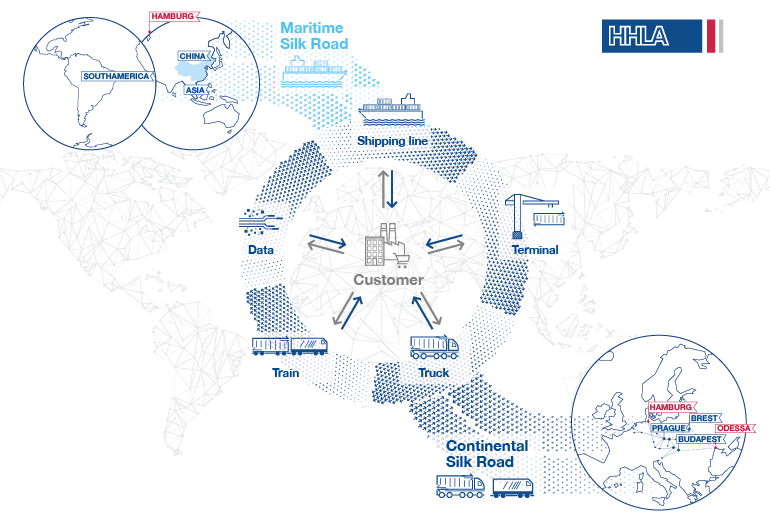Corporate Strategy
HHLA’s strategy is aimed at taking a leading position as a port logistics provider and thus achieving sustainable growth in its enterprise value. With its business model of vertical integration throughout the transport chain between the international seaport and its European hinterland, HHLA believes it is favourably positioned to benefit from the expected growth in trade. Hamburg’s role as a logistics hub plays a key role here. Sustainable business practices form an integral part of the corporate strategy.
HHLA’s Executive Board initiated a business development process at the beginning of 2017 with the aim of strengthening HHLA’s future viability and dynamism over the long term. The necessary changes are linked across all segments and underpinned by a series of measures. The defined objectives are pursued systematically.
The permanent nature of the process enables the company to react swiftly and in a targeted manner to the increasing pace of change. It focuses on paying close attention to relevant market trends, safeguarding efficiency and forging links within the company, with customers and partners, and also with the forwarding industry and trade, while ensuring that all corporate activities are agile, flexible and effective.
Logistical and Digitally Innovative Hub on the Silk Road
With its prime objective of making HHLA a logistical and digitally innovative hub on the emerging “New Silk Road”, the business development process is focusing on the following navigation milestone: HHLA comes from Hamburg and is at home in Europe. As a gateway to the future, it offers its customers the best way to transport their goods safely, quickly and efficiently.
HHLA's Service Network
HHLA connects its customers with the maritime and continental Silk Road:

Corporate Strategy
Sustainably increasing enterprise value at HHLA

Four initiatives have been identified to achieve this objective:
- Fit for tomorrow’s world: Our core business is being strengthened to enable sustainable, profitable trading in tomorrow’s world. A corresponding programme for the future is being implemented. This programme aims to enhance competitiveness, quality and profitability.
- Tapping new growth areas: HHLA is tapping growth potential along the transport flows of the future, along the logistics value chain and in new, digital business models.
- Organisation and corporate culture: The company organisation and culture are being aligned with tomorrow’s world. The client is being placed more than ever at the centre of all activity.
- Investments and finance: The company will continue to gear its investments and operating results towards sustainable, profitable growth.
The core of our business is dominated by the subgroups Real Estate and Port Logistics.
In its non-listed Real Estate subgroup, HHLA pursues a long-term and demand-oriented approach to developing districts and properties. The main focus is on developing existing properties, many of which are designated as historical landmarks.
In order to consolidate and further expand the Group’s market position, HHLA is currently pursuing the following guidelines for the listed Port Logistics subgroup:
HHLA strives to constantly improve its competitiveness by further enhancing its service quality and technological capabilities. It concentrates both on retaining its broad customer base and attracting new clients.
In the Container segment, HHLA will continue to pursue its strategy of providing a neutral service to as many shipping companies as possible in the handling of ships and the coordination of berths, thus ensuring a high quality of service for all customers. HHLA also aims to become a quality and efficiency leader in the activities of its Intermodal segment by continuing to invest in its own facilities and equipment, such as inland terminals, container-carrying rail wagons and locomotives. Due to its consistent establishment and expansion of pre- and onward-carriage rail systems and their integration into maritime transport chains, HHLA is able to offer its customers a perfectly coordinated range of services.
HHLA plans to continuously improve the services it provides by expanding intermodal transport between the international port and the hinterland. Besides enhancing the scope and range of its services, HHLA also focuses on increasing its vertical integration.
HHLA therefore intends to further expand the market position of its Intermodal subsidiaries. Investments here will concentrate on inland terminals and connecting them to international ports via direct links. By acquiring its own rolling stock (container wagons) and expanding its own traction fleet (locomotives), the company is gradually increasing vertical integration so that it can largely operate independently on the market. HHLA is accompanying these measures by expanding its trucking services.
In addition to purely organic growth, HHLA is examining opportunities for acquisitions. Potential acquisitions and equity investments focus on port projects and shareholdings in attractive growth markets. HHLA’s interest is based on the economies of scope offered by the existing network and the opportunities it presents to tap additional potential.
A port’s catchment area.
Payments for investments in property, plant and equipment, investment property and intangible assets.
In maritime logistics, a terminal is a facility where freight transported by various modes of transport is handled.
Transportation via several modes of transport (water, rail, road) combining the specific advantages of the respective carriers.
The action of a locomotive pulling a train.